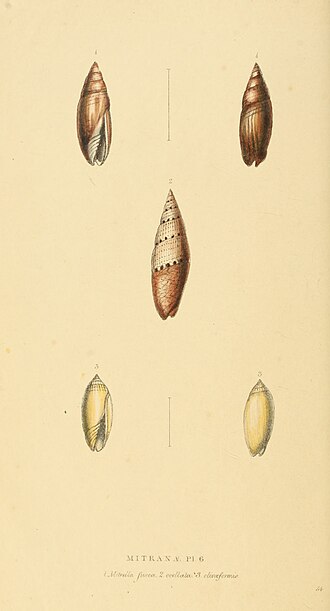Zoological Illustrations Series II/Plate 54
MITRANÆ. Pl. 6.
1. Mitrella fusca. 2. ocellata. 3. olivæformis.
MITRELLA fusca.
Family Volutidæ. Sub-family Mitriana. Nob.
Generic Character.
Shell smooth, polished, sub-fusiform, the base obtuse and effuse; the plaits of the pillar oblique, and extending far beyond the aperture; outer lip internally smooth, the margin entire. Nobis.
Types of form.
1. M. fissuella. 2. casta. bicolor. 3. Olivæformis.
Specific Character.
Shell entirely brown, marked by bands of punctured dots; spire and aperture nearly equal.
The natural situation of this group, in its own circle of affinity, has already been shewn; it connects, in the most satisfactory manner, the genus Mitra, as now restricted, with that of Conohelix, and opens at the same time a passage to the Olives. The species yet discovered are few, and hence we yet can only trace three types of form; the first evidently representing Mitra, and the third, probably, typifying Conohelix. M. Olivaria Lam., which truly belongs to this genus, may, perhaps, be only a modification of the 2nd type, to which our present species strictly belongs. The representation of this group among the Volutes, will be found in Voluta Zebra and its allies.
Mitrella fusca is small, and of great rarity; our own specimen, beautifully perfect, is the only one we have yet seen.
MITRELLA ocellata.
Shell whiteish, the lower half of the principal whorl brown, with a band of alternate rufous and white spots, and marked with reticulated white lines, and remote sulcaled striæ, internally punctured; spire, and upper part of the body whorl, delicately plaited, the plates crossed by transverse lines of excavated dots.
This species has probably been overlooked as a variety of M. Fissurella; its markings, indeed, are partially the same, but its sculpture, and even its form, proves it to be distinct. The alternate white and rufous spots bear a fanciful resemblance to eyes. The description of M. Olivæformis has already been given at Pl. 48, in the first volume of our former Series.
